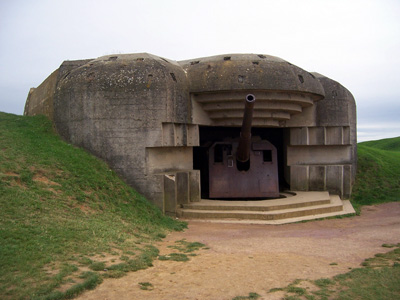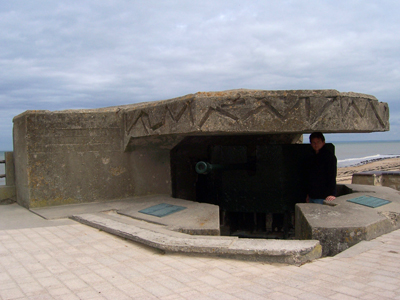
WWII: Maginot Line | Normandy | V-Weapon Sites | Arnhem
Further afield: Crete
| Home Tracing Military Ancestors Travel Advice CWGC Cemeteries Iron Harvest News Book Reviews Glossary Links Contact Me Normandy Landings:
 
|
The German Defences
Realising the impetus the American entry into the war would have in the West, in March 1942, Hitler had decreed the construction of an “Atlantic Wall” incorporating 15,000 strongpoints to deny any Allied landing. However, it was not until after Field-Marshal Erwin Rommel was appointed as Inspector of the Atlantic Wall in December 1943 that the various works began to be organised into an integrated defensive system. Touring likely invasion beaches all the way from Denmark to Brittany, Rommel noted huge deficiencies in the thickness and quality of the defensive zone and immediately set about rectifying matters. He paid particular attention to beach defences. Assuming that any major Allied landings would be during a rising tide when the assault troops would have a shorter stretch of exposed beach to cross, Rommel ordered the construction of a whole array of beach obstacles leading up to the high tide mark. These included wooden stakes with mines attached, jagged metal obstructions furthest from the shore and designed to sink landing craft, and tank obstacles and covered mines further up the beach. Rommel hoped these would pin the attackers on the beach long enough for them to be annihilated by the coastal strongpoints. These strongpoints, known as “Wiederstandnestes” and marked as “WN” on Allied military maps, varied in construction and garrison size depending on terrain and task. They contained a mixture of machine-guns, mortars, anti-tank guns and artillery inside entrenched and/or reinforced concrete positions surrounded by mines and/or barbed wire. Further inland Rommel had ordered construction of a second line of defences exemplified by the strongpoints code-named “Morris” and “Hillman” north of Caen with the aim of disrupting any advance inland and allowing German armoured reserves time to concentrate against the landing area. Construction of these defences was less well advanced and many were still some way from completion on D-Day itself. To the beach defences, “Wiederstandnestes” and second line positions, could also be added a number of coastal batteries set within formidable reinforced concrete emplacements. Designed to bombard and sink Allied shipping during the landing phase, some of these batteries, such as those at Merville and Pointe du Hoc, were dangerous enough to warrant individual assault operations by specially trained commandos and paratroopers.
To garrison the Normandy defences Rommel had a rather mixed collection of units. Due to the widely held belief that any invasion would come across the Straits of Dover, the best German divisions had been concentrated in the Pas de Calais and Dieppe regions. Covering Normandy were five divisions of varying quality. The 709th, 711th and 716th Coastal Defence Divisions possessed limited artillery and engineer assets and were distributed between the mouth of the River Seine and Cherbourg. They also included large numbers of soldiers that were either deemed too old for the Russian front or were recovering from wounds and “Osttruppen” - captured Poles, Russians and Ukrainians pressed into German service. In the centre of the Contentin peninsula 91st Luftlande (Airlanding) Division contained two grenadier regiments and the reliable 6th Parachute Regiment. Meanwhile the 352nd Infantry Division, positioned in the coastal sector between Bayeux and Carentan just a month prior to D-Day, were a more experienced unit with significant amounts of artillery and a proportion of Eastern Front veterans. Whatever their deficiencies, however, it was hoped that, should the Allies decide to land in Normandy, these infantry units could delay the attackers until they received support from the German Panzer reserves. It was the command, control and positioning of these that was to prove the most controversial aspect of the entire German defence plan. Field-Marshal Von Rundstedt, Commander-in-Chief West, with his immense experience on the Eastern Front and in accordance with standard doctrine, preferred to hold the armoured reserves well back until the location of the main invasion became apparent. A concerted counter-attack could then be launched to throw the Allies back into the sea. Rommel, appointed commander of all forces in France, Belgium and Holland in February 1944, disagreed. Fighting the Allies in North Africa had demonstrated to him the crushing power of their air forces, which, by 1943, far eclipsed the Luftwaffe in terms of quantity and sometimes quality too. He believed any concentrations of armour would be destroyed from the air as soon as they entered the battle zone. His solution was to position all eight panzer divisions in the West along the coast. Although this meant a lack of concentration, he argued that small groups of armoured vehicles at critical landing beaches early on might be enough to thwart the assault troops before they had time to establish themselves. Dispersed reserves would also be much more difficult for Allied fighter-bombers to target. Both generals lobbied Hitler for a final decision, which satisfied neither commander. Rommel was given command of three of the panzer divisions, but the remainder were split between von Rundstedt’s and SS command. To make matters worse, Hitler decreed that no armoured reserves could be moved without his personal authority! The lack of a clear strategy and logical chain of command in this vital respect, meant that, with the exception of some units of 21st Panzer Division based south of Caen, there were no German armoured reserves close enough to the Normandy beaches to mount any counter-attacks on D-Day. Despite the confusion surrounding command and control of the panzer divisions, however, there is no doubt that by May 1944, under Rommel’s direction, the Atlantic Wall in the Normandy sector represented a hugely formidable obstacle to the Allied invasion machine. How to breach it and, equally importantly, how to move reinforcements into Normandy by sea quicker than the Germans could by land, had been the focus of Allied tacticians, scientists and industrialists since the dark days of the Dieppe raid. The solutions that they provided, often to the tightest of deadlines, were some of the most incredible yet seen in the history of warfare. |

